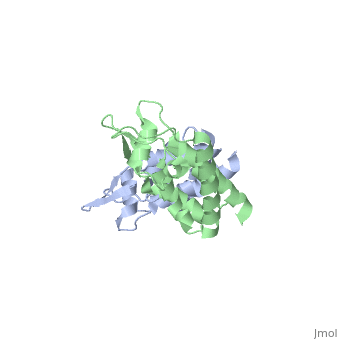2wlv
From Proteopedia
Structure of the N-terminal capsid domain of HIV-2
Structural highlights
FunctionGAG_HV2RO Matrix protein p17 targets Gag and Gag-pol polyproteins to the plasma membrane via a multipartite membrane binding signal. Also mediates nuclear localization of the preintegration complex (By similarity). Capsid protein p24 forms the conical core of the virus that encapsulates the genomic RNA-nucleocapsid complex. Nucleocapsid protein p7 encapsulates and protects viral dimeric unspliced (genomic) RNA. Binds these RNAs through its zinc fingers (By similarity). p6-gag plays a role in budding of the assembled particle by interacting with the host class E VPS proteins TSG101 and PDCD6IP/AIP1. Evolutionary ConservationCheck, as determined by ConSurfDB. You may read the explanation of the method and the full data available from ConSurf. Publication Abstract from PubMedTRIMCyps are primate antiretroviral proteins that potently inhibit HIV replication. Here we describe how rhesus macaque TRIMCyp (RhTC) has evolved to target and restrict HIV-2. We show that the ancestral cyclophilin A (CypA) domain of RhTC targets HIV-2 capsid with weak affinity, which is strongly increased in RhTC by two mutations (D66N and R69H) at the expense of HIV-1 binding. These mutations disrupt a constraining intramolecular interaction in CypA, triggering the complete restructuring (>16 A) of an active site loop. This new configuration discriminates between divergent HIV-1 and HIV-2 loop conformations mediated by capsid residue 88. Viral sensitivity to RhTC restriction can be conferred or abolished by mutating position 88. Furthermore, position 88 determines the susceptibility of naturally occurring HIV-1 sequences to restriction. Our results reveal the complex molecular, structural and thermodynamic changes that underlie the ongoing evolutionary race between virus and host. Active site remodeling switches HIV specificity of antiretroviral TRIMCyp.,Price AJ, Marzetta F, Lammers M, Ylinen LM, Schaller T, Wilson SJ, Towers GJ, James LC Nat Struct Mol Biol. 2009 Oct;16(10):1036-42. Epub 2009 Sep 20. PMID:19767750[1] From MEDLINE®/PubMed®, a database of the U.S. National Library of Medicine. See AlsoReferences
| ||||||||||||||||||
Categories: Large Structures | James LC | Lammers M | Marzetta F | Price AJ | Schaller T | Towers GJ | Wilson SJ | Ylinen LMJ


